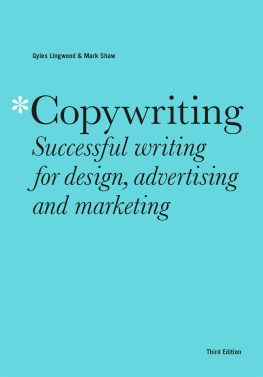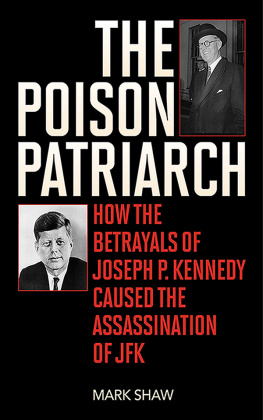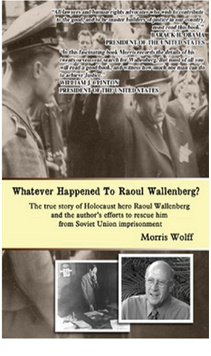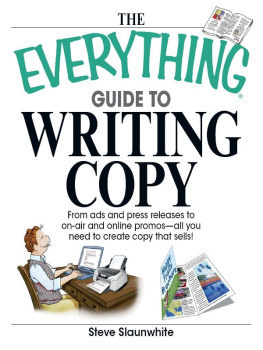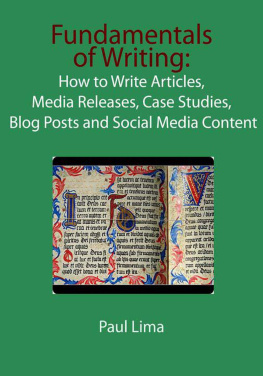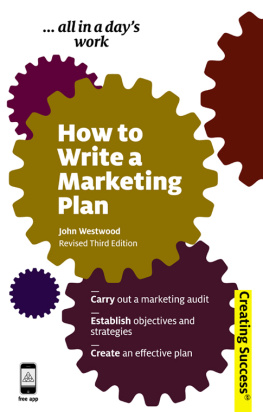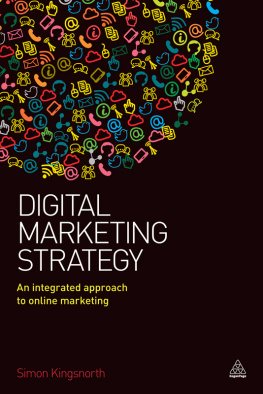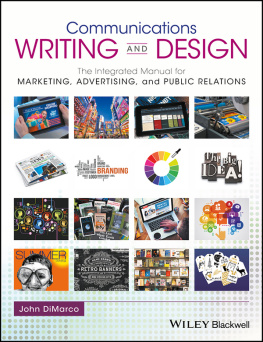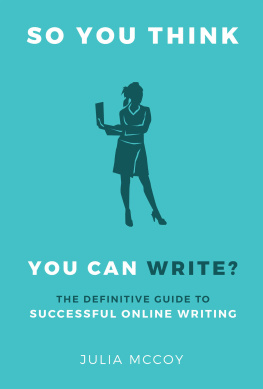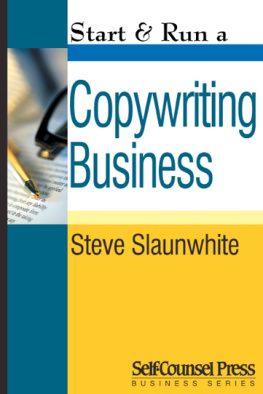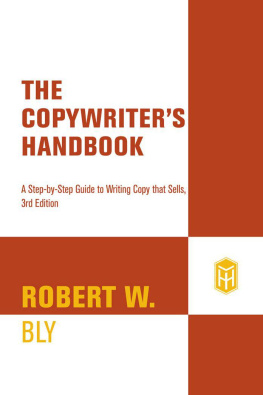Contents
Guide
Copywriting
Successful writing for design, advertising and marketing
Third Edition
Gyles Lingwood & Mark Shaw
Copywriting
Successful writing for design, advertising and marketing
Third Edition
An imprint of Quercus Editions Ltd
www.laurenceking.com/pages/student

For Leilah, Sam and Fin (MS)
For Kath, Oscar and George (GL)
First published in Great Britain in 2022 by
Laurence King Student & Professional
An imprint of Quercus Editions Ltd
Carmelite House
50 Victoria Embankment
London EC4Y 0DZ
An Hachette UK company
Copyright Text 2009, 2012, 2022 Mark Shaw, Gyles Lingwood
The moral rights of Mark Shaw and Gyles Lingwood to be identified as the authors of this work have been asserted in accordance with the Copyright, Designs and Patents Act, 1988.
All rights reserved. No part of this publication may be reproduced or transmitted in any form or by any means, electronic or mechanical, including photocopy, recording, or any information storage and retrieval system, without permission in writing from the publisher.
A CIP catalogue record for this book is available from the British Library
TBP ISBN 978-1-52942-024-1
E-BOOK ISBN 978-1-52942-025-8
Quercus Editions Ltd hereby exclude all liability to the extent permitted by law for any errors or omissions in this book and for any loss, damage or expense (whether direct or indirect) suffered by a third party relying on any information contained in this book.
Design by Studio Ten and a Half
Research for first and second editions by Tim Shaw
Contents
Preface
Whats the big deal about copywriting? Theres so much writing out there, in every shape and form on every topic and field, and everyone is writing and publishing copy all the time these days. Why dont we just let people get on with it? Well, the enormous volume of self-published, unedited writing is the very reason why the skills and techniques of copywriting are more essential than ever before. A friend of mine recently described the situation as Weve all got Maths GCSE but we wouldnt do the company accounts, so just because weve got English GCSE, why do we think we can write great copy?
A brand is a persons gut feeling about a product, service or organization. From an organizations standpoint, a brand is the promise that it makes to its target audiences, and that promise has to be delivered accurately if you are to build long-term relationships with your customers, suppliers and employees.
Increasingly, businesses are being designed from the point of view of the customer experience, with every point of contact being shaped to suit their requirements. Branding is part of every business, no matter how big or how small, and you can play a crucial role in the success of an enterprise by helping it to use effective communication to build bridges and develop profitable relationships with its audiences.
Understanding your own brand takes a bit of thought, and as a copywriter you will do well to follow these processes to identify the qualities within you and your business that make you who you are, and which you will be promising to your audiences (or rather, clients). These qualities are formed from values. Values are the bedrock of any organization, or individual, and are made up of attitudes and beliefs.
When you take a copy brief, you will be picking up all sorts of insights into the attitudes and beliefs within an organization. Keep a clear note of these, and build a picture of the values that you are drawing out. Present these back to your client to double-check them, as these will form the foundation of your messaging.
Messaging is the term that is being used increasingly to describe the way a business or organization writes. The tools within messaging are typically a strapline or tagline, a word bank of commonly used phrases, a list of core messages that you wish to reinforce consistently and a tone-of-voice guide, which gives examples of the style of writing that reflects the values in the organization. If youre writing for business, you should start to familiarize yourself with these tools, as they are where the future of branding lies.
Digital messaging is all about creating bite-sized pieces of information that engage and direct the reader. Formats are increasingly diverse, with many new digital channels now in the mix. Customers pick up marketing messages on TV, in the press and from billboards as much as they ever did, and these are supplemented by websites, social media sites, mobile phone messaging, and media screens in public places just about everywhere we go. These messages need to be managed well to ensure that the same benefits and calls to action are communicated clearly and consistently throughout all of these touchpoints.
We need copywriters to do the best job of this communication. Too often these projects are left to managers who may know the product inside out but rarely know how to prioritize a message, shape it for a target audience and instil the values of the organization into the text. Copywriting requires all of the design thinking that goes into any other creative aspect of a business. Great writing is the route to great business!
Knowledge, no matter how precious, needs to be shared. If it isnt, it dies. If it is, it will live, and evolve. One of the most common ways that knowledge can be passed on is in the form of a carefully prepared textbook.
Theoretically, it should be possible for a complete non-swimmer to study an authoritative textbook on swimming that explains and demonstrates all of the disciplines and approaches, then jump in the deep end and swim with style and grace. How difficult can it be? The reader can see how easily swimmers cut through the water, and she can read and absorb all of the relevant principles and techniques. If she breathes, moves and applies herself properly, it should be simple.
Except we know that this wont work. In reality, we learn to swim gradually, adapting to the watery environment and building our confidence over time, through trial and error.
So what about creative business writing? Can a well-prepared textbook teach you to be an accomplished copywriter, even if youve never written copy before? Not if youve never written a word in your life before, but luckily for you, youre not a complete novice. Youve been writing since you were a child, and youre already fully immersed in the world of words.
This textbook shares the knowledge about creative writing so that it can live and evolve, but it is not a guide to sales and marketing, and it is not a manual on grammar and punctuation. It aims to explain the processes that you can follow when writing copy, and reveal the secrets about how the best copywriters do it.
Writing copy is not as hard as it looks. Its the creative thinking that goes on behind the writing that is the challenge, and the focus of this textbook is firmly on these fascinating aspects of the rewarding field of copywriting.
You can dip in and out, or read it cover to cover and complete the exercises; either way, I hope you will gain some valuable insights. The bottom line is that if you can understand who youre writing for, what youre really saying to them, what it takes to make this interesting, and how to shape your messages to suit their preferences, you will be writing professional copy.

